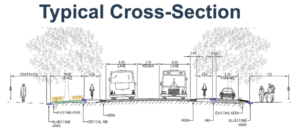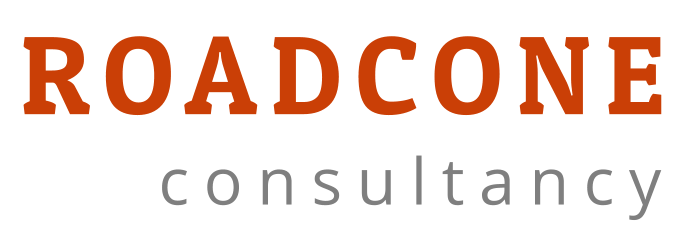CONSULTANCY, PLANNING, DESIGN & REVIEWS
Our services include:
* Consultation (pre-planning and advice).
* Council, NZTA and local authority approvals.
* Sourcing plans & markouts of existing utility services.
* Traffic Management Plan (TMP) design – including site specific diagrams.
* TMP review service. If you are not fully TTM Planner (P) qualified, we can review your TMP for you.
Services
Who we are
FAQs

Roadcone Consultancy can help you to identify the potential impact of your project and create a Traffic Management Plan that will focus on safety and compliance with all relevant regulations.
We have extensive experience creating TMPs & CARs for all sorts of organisations in a wide range of industries.
If you’re not sure what’s involved you can be sure that we can help. Start with the FAQ at the bottom of this page.
Roadcone Consultancy
….
Who we are.
Michael Gray is a Waka Kotahi NZTA qualified TTM Planner (P) and a Category (ABC) -NP STMS.
Michael has been an STMS since 2016.
He is also a keen (but average) sailor and cyclist.
Michael lives in the Wellington suburb of Miramar.
The image in this background is not him.
Where to start?
If your project is within a road reserve or you need to manage traffic for an event, you might be wondering where to start. Roadcone Consultancy are experts in Temporary Traffic Management Planning. We can look after all your TMP and CAR paperwork so you can focus on the rest of your project.
Working Within The Road Reserve?
Roadcone Consultancy can own the entire Traffic Management Plan & Corridor Access Request for you.
Contact us today and we’ll be happy to discuss what you’re planning and how we can best support you to get your project done.
The right contacts.
We work with local authorities every day to help our clients carry out work within the road corridor.
That means we know who to contact, and what information they need to see in order to issue your organisation with an approved TMP and a Work Access Permit (WAP).
FAQ’s
What is a 'FAQ'?
Frequently Asked Question
What is the 'road reserve'?
From the boundary on one side of the road to the boundary on the opposite side. The road reserve also includes an airspace of six metres directly above the road surface.

What is TTM?
Temporary Traffic Management.
Officially: ‘The process of managing road users through or past a closure in a safe manner with minimal delay and inconvenience.’
What is a TMP?
The Traffic Management Plan describes how all road users (including all vehicles, cyclists & pedestrians) and the work crews will be kept safe on your worksite.
It is a document describing the nature and extent of TTM at a worksite and how all road users will be safely managed by the use of TTM measures.
Depending on the size, duration and location of the worksite, multiple TMPs (or a TMP with multiple TMDs) may be required for various stages of the work.
TMPs must include local authority requirements (such as how to manage pedestrians, cyclists and parking).
Where regulatory parking and stopping areas are to be affected by the works additional consultation time may be required during planning for the activity.
Once approved, a copy of the TMP must be kept on the worksite and made available to anybody wanting to do a site audit.What information do I need to provide to start this process?
For the TTM Planner to craft a quality TMP that will be approved by the RCA, you will need to provide:
- a detailed Scope of Works, Construction Plan or similar type plan.
- Information about the type, quantity & location of your work vehicles. For larger and/or specialised vehicles, this may include details about how they arrive at (and depart) the worksite.
- Organisation name, Contact Person Name, contact phone & contact email for the Client or ‘Principal’ that the work is being done for. Typical examples are utilities such as power, water & telecommunications companies.
- Organisation name, Contact Person Name, contact phone & contact email for the ‘Bill Payer’ that will be paying the CAR application fees. Why is this? See FAQ further down this page. The ‘Bill Payer’ is usually from the same organisation as the Client / Principal but may be in a different part of that organisation – typically a finance or accounts team.
For smaller organisations, the Client/Principal & the Bill Payer may be the same person. - Organisation name, Contact Person Name, contact phone & contact email for the ‘Contractor’ that will be doing the actual work.
- A completed and signed ‘A3’ form – can be sourced from HERE (link) scroll down to Page 5.
On this A3 form, you will detail…
- A ‘plain english’ (no jargon) description of your project.
- A breakdown of the significant stages of your project. This is because the TTM may vary for each stage.
Example:
‘Connect a new 300mm stormwater pipe from the bottom of the walkway next to #235 Hillary St to the existing manhole in the intersection of Hillary St & Tensing Rd’
1. Cone off worksite on the day prior,
2. Deliver large digger to site (requires 25m long low loader).
3. Excavate in carriageway to lay new stormwater pipes with Two Way Stop Go to manage traffic.
4. Backfill and temp reinstate road surface.
5. Leave site overnight with Temp Speed Limit signage in place.
6. Return to site next day and complete permanent reinstatement.
Include info about any unattended state – e.g. will any work vehicles be left on the roadside overnight? Will the footpath be left fenced off while concrete sets.? - The planned duration of your project (number of days/weeks/months).
- The planned operating hours of your project worksite (e.g. Monday to Friday, 8am to 5pm).
Be aware that some roads have limits to the working hours that will result in you having a smaller window of time to complete your works than you may have planned for.
There may also be other factors affecting the hours you are allowed to work.
Common examples are works near schools & works at night.
Roadcone Consulting will advise you about any of these limits.
The TTM Planner will then:
- Identify all matters to be addressed.
- Plan the closure(s).
- Plan for other considerations.
- Plan for the road users.
- Resolve any conflicts.
- Gather and submit other pre-approval documentation (e.g. for bus operators, traffic signals, parking services, noise control and other authorisations).
- Develop the Full TMP.
- Submit the Full TMP for approval.
What is a Corridor Access Request (CAR)?
A Corridor Access Request (CAR) notifies the relevant local authority of your plans to work within the road corridor.
It includes details of the work you’re planning to carry out, timings and dates, and a Traffic Management Plan.
The Traffic Management Plan shows how you will manage the flow of traffic for maximum safety and minimum disruption during the time you are working within the road corridor.If your local authority (RCA) approves your Corridor Access Request they provide a stamped (‘approved’) TMP and they will issue your organisation with a Work Access Permit which is your authority to carry out the work.
When do you need a Corridor Access Request?
If your project requires work anywhere within the road reserve, or is an event or activity that may disrupt the flow of traffic within the road reserve, you need a Corridor Access Request.
What type of CAR do I need?
Before we apply for a CAR, we need to know if your work involves excavation or not;
If you are:
- undertaking any activity that may break or damage the surface of the road reserve (including carriageways, footpaths, cycle lanes and berms);
- placing any pipe, duct, pole, cabinet or other structure below or on the road reserve.
then you require an EXCAVATION type CAR.
If you are:
- Accessing existing infrastructure such as roadside cabinets, pits, manholes & poles.
- Temporarily installing construction loading zones
- Placing a skip/bin or container in the road reserve
- Putting up temporary scaffolding (mobile or fixed)
- Using or parking machinery such as cranes, cherry pickers and water blasters in the road reserve.
- Applying for a full or partial road or footpath closure to carry out work on or above the road reserve e.g. tree trimming or felling.
Then you require a NON-EXCAVATION type CAR.
If you are holding an event, protest or parade that affects vehicle or pedestrian traffic then you require ….. an EVENT type CAR.
How long will it take to get a TMP & CAR approved?
TMP preparation times can vary depending on complexity of the job but as a guide you should allow between 5 ~ 10 working days for the TMP to be crafted.
After that, the TMP is submitted on a CAR to the RCA (council and/or NZTA) and for them to process the CAR you should allow the following times:
- For local councils, non-Excavation jobs: 5 working days.
- For local councils, Excavation jobs, Events & helicoptor lift jobs: 15 working days.
- For NZTA, any type of works: 30 working days.
Example 1: Accessing a manhole (non-Excavation) within a local council area… (up to) 10 working days for the TMP plus 5 working days for the CAR processing = 15 working days total.
Example 2: Excavating in the shoulder of a state highway (Waka Kotahi NZTA) area… (up to) 10 working days for the TMP plus 30 working days for the CAR processing = 40 working days total.
NOTE: Once you have an approved TMP & a WAP issued, State Highway works (and some local councils too) then require a third step : a booking on their Road Works Report (RWR).
The idea here is to lock in a slot and avoid clashes with any other contractor works in the same space.
Typically, this RWR booking must be made in the week before you plan to commence your works – usually on a Thursday.Without a slot booked on the Road Works Report, you cannot commence your work.
Why do I need to pay CAR fees directly to the RCA? ('Bill Payer')
Each (local) authority – the RCA – charges a fee to cover their costs for processing the Corridor Access Request. This is not just the initial submission but also for any inspections, extensions and warranty follow-ups that the RCA may need to undertake.
Roadcone Consulting cannot invoice you directly for these fees as the total is not known in the initial submission.
Hence, a person or team in your organisation must be nominated as the ‘Bill Payer’ for the CAR fees and you will be invoiced directly by the RCA for these.
See the Wellington City Council website (LINK) for example CAR fees.Additional note: An excavation CAR has a two year warranty period which commences once the ‘Work Complete’ milestone has been signed off.
Any issues that the RCA may have with your excavation within that two year period, they will come back to you and may charge additional CAR processing fees for this follow-up work.Who / what is the RCA?
The Road Controlling Authority is either the council (for local roads) or Waka Kotahi NZTA (for state highways).
Depending on the location and the work required, your project may sometimes need approval from both RCA’s.
The RCA approves the TMP and issues a WAP – Work Access Permit.
Once you have a WAP and an approved (digitally stamped) TMP then you may schedule your project to start.What is a Work Access Permit (WAP)?
When the local authority approves your Corridor Access Request they will issue you with a Work Access Permit.
This is your formal approval to commence with your project.
The WAP lists the Start and End Dates of your project, these dates need to be aligned with the dates on the TMP.
What is 'CoPTTM'?
The New Zealand Code of Practice for Temporary Traffic Management (LINK). A 567 page document which provides comprehensive details of the disciplines and requirements for temporary traffic management in NZ.
As of November 2022, Waka Kotahi NZTA is also promoting the New Zealand Guide to Temporary Traffic Management (LINK)
In time, the NZGTTM will replace CoPTTM.
What is 'NZGTTM'?
As of May 2024, WTA (Wellington Transport Agency – representing NZTA) will soon move further into promoting the New Zealand Guide to Temporary Traffic Management (LINK)
What is a 'Parent / Child' CAR submission?
Some RCA’s allow for smaller scale works which are of a repetitive nature to be done under an arrangement known as ‘Parent / Child’ CAR Submissions.
A Generic TMP is submitted on a Parent CAR with a number of Generic Traffic Management Diagrams (TMDs) which will cover multiple different work situations.
The Generic TMP will outline the task (e.g. sump replacement, tree maintenance, footpath rehabilitation, etc.) and will also typically list any situations or specific areas where the Generic TMP cannot be used.
For example; not on a specific road or list of roads, not in a Central Business District, not during certain hours.
The Generic TMP will usually have valid dates lasting for 6 – 12 months.Once the Generic TMP has been submitted on a Parent CAR and approved by the RCA then subsequent ‘Child CARs’ can be submitted for specific worksites.
These Child CARs are submitted with a ‘Cover Note’ which is a one page description that lists info such as:
* a reference to the Parent CAR number
* the location of the work
* the type of work to be done at this location
* the dates that the work will take place
* the Child CAR Ref number
* the Generic TMD ref numbers that the work will require – for both Attended & Unattended state.
* any other info specific to that site e.g. school nearby, bus route affected, etc.
* copies of the Generic TMDs (diagrams) that will be required for this location.
* a sign-off by a TTM PlannerCompliance
Our area of expertise is understanding and keeping up to date with the rules and regulations that govern working on and around the roads of New Zealand.
Failure to comply with these regulations is a criminal offence.Roadcone Consultancy can help you to identify and outline the potential impact of your work and create a Traffic Management Plan as part of the Corridor Access Request that will focus on safety and compliance with all relevant regulations.
We have extensive experience creating TMPs & CARs for all sorts of organisations in a wide range of industries.
If you’re not sure what’s involved, please contact us (LINK) for help.I have my approved TMP and WAP. Now what?
Depending on the scale and complexity of your project, it is likely you will now need to engage a dedicated TTM provider who has the resources to implement the TMP. This includes:
- qualified staff
- traffic trucks
- signs
- cones
- other safety equipment.
Roadcone Consultancy does NOT supply any TTM equipment but we have good relationships with such providers and can make recommendations if needed.
NOTE: Once you have an approved TMP & a WAP issued, State Highway works (and some local councils too) then require a third step: a booking on their Road Works Report (RWR).
The idea here is to avoid clashes with any other contractor works.Typically, this RWR booking must be made in the week before you plan to commence your works – usually on a Thursday.
Without a ‘slot’ booked on the Road Works Report, you cannot commence your work.I am ready to start my project. Do I need to tell anyone?
Yes.
Part of your Work Access Permit is a condition to advise the RCA that you have begun the project works.This is done by setting the Work Start date in Submitica and can be completed by anyone who has been granted access to your CAR submission.
It’s usually quickest just to contact Roadcone Consultancy (LINK) and we will do this for you.I've finished my project. Do I need to tell anyone?
Yes.
Part of your Work Access Permit is a condition to advise the RCA that you have completed the project works.This is done by setting the ‘Work Complete’ date in Submitica and can be completed by anyone who has been granted access to your CAR submission.
It’s usually quickest just to contact Roadcone Consultancy (LINK) and we will do this for you.IMPORTANT: If your project involved any excavations, then you MUST provide:
- Compaction test results
- Photos of the permanent reinstatement.
- A signed ‘A9’ form – can be sourced from HERE (link) scroll down to Page 15.
These documents must all be uploaded to the CAR (Submitica) so the RCA has visibility of them.
Usually quickest and best to email these documents to us at Roadcone Consultancy (LINK) and we will upload them for you.
This is so the RCA can commence the two year warranty of your works.
Failure to do this may result in (re)inspection fees and Late Notice fees being issued to you by the RCA.Enough chat, let me fill out a TMP / CAR Request Form.
Sure thing.
Go HERE.
I'd like to read the Roadcone Consultancy Ltd Terms and Conditions please.
Sure thing.
Go HERE.
I'd like to see the Roadcone Consultancy Ltd Rate Card please.
Absolutely.
Go HERE.



